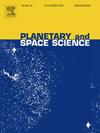Comet P/2003 T12 (SOHO): A possible fragment of comet 169P/NEAT?
Abstract
This work provides insights into the possible origin of comet P/2003 T12 (SOHO) and the dynamics of comet fragmentation events. We studied the hypothesis of the origin of the comet P/2003 T12 (SOHO) as a fragment of the Jupiter family comet 169P/NEAT. We studied the recent dynamical evolution of the comet pair and determined the epochs of relative minimum distance and velocity as well as the similarity between the orbits using different criteria following Rożek et al. (2011) and Kholshevnikov et al. (2016). We generated 6000 clones of both comets with orbital elements compatible with the observational uncertainties of the actual orbits and found that their evolution is stable for the past 5000 years. We found four epochs where the relative distance and velocity exhibit simultaneous minima. We studied possible fragmentation events in these epochs by applying a simple break-up model for the generation of fictitious fragments at different relative speeds. Analyzing the orbital distance between the fragments, we found some fragments that exhibit noticeable stable behavior at a very low mutual orbital distance according to several distance definitions, which suggest that those fragments evolve in orbits very similar to that of the P/2003 T12 (SOHO). We conclude that comet P/2003 T12 (SOHO) could be a fragment of comet 169P/NEAT and the most likely epoch for such fragmentation would be at least 2000 years ago (around 94 A.D.), given that the fragments that best resemblance comet P/2003 T12 (SOHO) are found in this epoch.

 求助内容:
求助内容: 应助结果提醒方式:
应助结果提醒方式:


